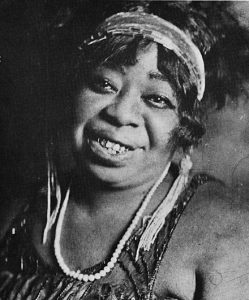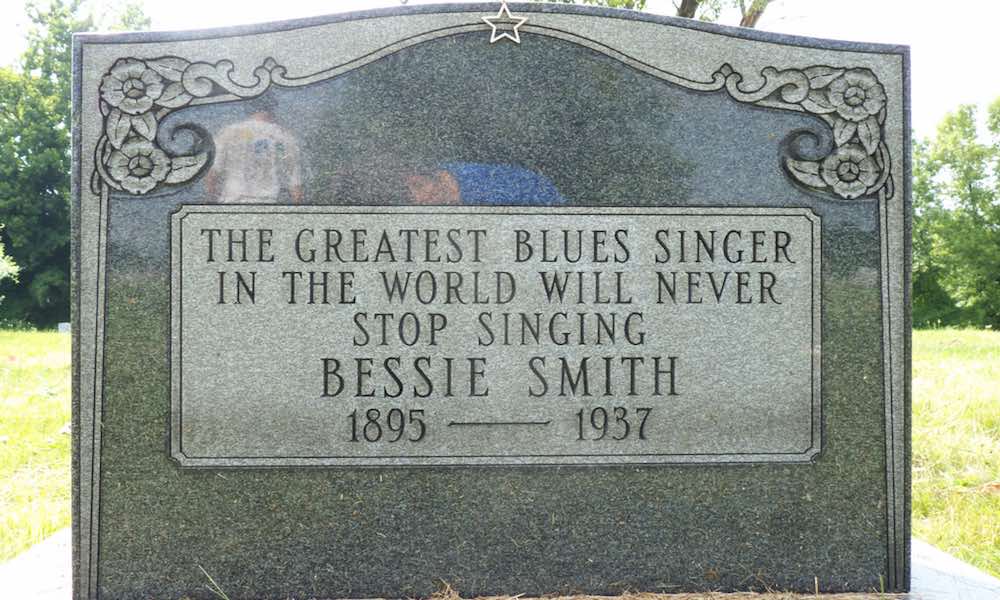Today we celebrate the birth – on April 15, 1894, 125 years ago today, in Chattanooga, Tennessee – of the American contralto Bessie Smith.
We Reflect on “GOAT”
When I was growing up, the word “goat” had two distinct meanings. First, there was the animal: a quadruped mammal, a member of the family Bovidae and subfamily Caprinae. There are presently over 300 distinct breeds of goat, both wild and domesticated. According to the United Nations Food and Agriculture Organization, in 2011 there were more than 924 million goats alive across the planet. (One can only wonder why there hasn’t been a more recent census.)
When I was growing up, the second meaning of the word “goat” was a loser: a derisive term for an athlete who, as a result of some monumentally boneheaded mistake, was responsible for his or her team’s loss. For example: Mike Torres, the Boston Red Sox pitcher who gave up a three-run homer to light-hitting, New York Yankee second baseman Bucky Dent in a one-game playoff following the 1978 regular season; or Bill Buckner, the Boston Red Sox first baseman who booted an easy grounder to lose game six of the 1986 World Series against the New York Mets; or Dan Duquette, general manager of the Boston Red Sox (is there a pattern here?) who in 1996 let pitcher Roger Clemens leave the team as a free agent, claiming that Clemens was in “the twilight of his career.” After leaving the Red Sox, Clemens went on to win four more Cy Young Awards, 2 World Series Titles, and 162 more games. Some twilight.
Amazingly, the word “goat” has undergone a 180-degree shift in meaning in recent years, as the acronym G.O.A.T. has come to refer to the “greatest of all time.”
By what standard(s) should anyone be considered the “greatest of all time”
I’ll admit that I’m an “intangibles” sort of guy, and therefore I will introduce a criterion without which no one should be considered a G.O.A.T. That criterion is that true G.O.A.T.-hood requires not just great stats, but that the individual in question should have redefined the game for everyone who followed. Based on my criterion, determining the greatest baseball player of all time is easy: he is Babe Ruth, because more than anyone else, it was George Herman Ruth (1895-1948) – the Babe, the Great Bambino, the Sultan of Swat, the Big Bam – whose style of play laid the groundwork for the game as we understand it today. Based on my criterion, determining the greatest basketball player of all time is not easy, because so many great players have contributed so many different things to the game.
(Speaking of old-style goats – meaning losers – let us not for a moment forget Harry Frazee, the owner of – yes – the Boston Red Sox who sold Ruth to the New York Yankees in 1919 and having done so, initiated the “Curse of the Bambino”, Boston’s World Series draught between 1918 and 2004!)
Does the concept of G.O.A.T. have any relevance to the world of the music beyond idle, perhaps even
Bessie Smith

Based on any conceivable criteria, when it comes to singing the blues, Bessie Smith (1894-1937) was the G.O.A.T.
The guitarist Danny Baker described Smith this way:
“Bessie Smith was fabulous to watch; she dominated a stage. She was a pretty large woman and she could sing the blues. If you had any church background, like people who came from the South like I did, you would recognize a similarity between what she was doing and what those preachers and evangelists did, and how they moved people. Bessie could bring about mass hypnotism. When she was performing, you could hear a pin drop.”
Bessie Smith’s life, her voice and her style of singing were collectively nothing less than an amalgam of Black American experience. She rose from abject poverty to international fame singing the blues, a music of protest and emotional pain that was created by Black Americans in the Deep South during the 1870s; a music that combines West African and European musical elements in equal part. She was as Danny Baker just described a big woman – nearly six feet tall and 200 pounds – and her gorgeous, deep, utterly singular voice was huge; she required no amplification to fill even the largest theaters or outdoor performance venues. The carrying power, trumpet-like edge and earthiness in her voice remind us, on one hand, of worker’s gangs singing “field hollers” and “shouts;” her passion and sadness and joy ring with the agonies and ecstasies of Black American life experience, church music and spirituals.
The exact date of her birth is still in question; the 1900 census states that she was born in July of 1892 and the 1910 census states that she was born on April 15, 1894. Since Smith herself celebrated her birthday on April 15, so will we.
She grew up hard. By the time she was

In 1912, the 18-year-old Smith signed on with a touring variety/vaudeville company owned by one Moses Stokes. She was hired as a dancer, as Stokes’ company already featured a well-known singer, Ma Rainey (born Gertrude Pridgett and billed as “Mother of the Blues”). Smith created her own act as a singer in 1913, performing across the South and Midwest and up and down the East Coast of the United States.

She made her first recordings in 1923 and ka-boom, her regional fame became national fame almost overnight. Smith’s first recording session – for Columbia records – took place on February 15, 1923. Columbia released her first record on its regular A-series; featuring Downhearted Blues on one side and Gulf Coast Blues on the other, it was a phenomenal hit, selling nearly 800,000 discs in 1923 alone. Bessie Smith was a gold mine, and she and Columbia cranked out the recordings. By the end of 1923, Columbia sold over two million Bessie Smith records. By the end of 1926, her sales had reached over six million records. (Columbia initially nicknamed her “Queen of the Blues,” but the public and the press quickly elevated her title to “Empress of the Blues” which, as the title of this post attests, it remains today!)
And while her blues recordings made Bessie Smith the highest paid black entertainer of her time, she branched out over the years, performing and recording show tunes and popular Tin Pan Alley songs as well. By doing so, Smith was instrumental in creating a repertoire of what came to be considered jazz standards.
Writing in their book Women and Rhetoric between the Wars (Southern Illinois University Press, 2013), Ann George, Elizabeth Weiser and Janet Zepernick assert that in terms of the subject matter of her material and in terms of her own life, Bessie Smith was a surprisingly – a shockingly – modern woman.
“What becomes evident after listening to her music and studying her lyrics is that Smith emphasized and channeled a subculture within the African American working class. Additionally, she incorporated commentary on social issues like poverty, intra-racial conflict, and female sexuality into her lyrics. Her lyrical sincerity and public behavior were not widely accepted as appropriate expressions for African American women; therefore, her work was often written off as distasteful or unseemly, rather than as an accurate representation of the African-American experience. Her work challenged elitist norms by encouraging working-class women to embrace their right to drink, party, and satisfy their sexual needs as a means of coping with stress and dissatisfaction in their daily lives. Smith advocated for a wider vision of African-American womanhood beyond domesticity, piety, and conformity; she sought empowerment and happiness through independence, sassiness, and sexual freedom.”
Rough and tumble though she was, Bessie Smith was the prototype for every pop diva who followed, a Black American woman who, thank goodness, didn’t “know her place.” Writes Gwen Thompkins, host of National Public Radio’s Music Inside Out:
“She was the first bisexual, alcoholic, horsewhipped-by-segregationists, beat-out-of-songwriting-royalties, lemonade-making, dark-skinned singing-sensation whose husband cheated on her with a light-skinned “Becky with the good hair.” But unlike Beyoncé’s rival in song, this “Becky” was Gertrude Saunders — a singer whose hair Smith tried pulling out by the follicles. A murderous fan? Check. Smith was stabbed in the stomach while on a triumphant return to Chattanooga. Arrests? Plenty. Disorderly conduct and illegal drinking often landed her in jail. Twerking? Possibly. As far back as the 1920s, Smith’s performances featured plus-sized women bent over and shaking enthusiastically, with their tushes facing the audience. Artistic reinvention? Of course. Interest in the blues was in decline before the Great Depression. That’s when Smith began writing and singing other kinds of songs that deepened her appeal to Southerners and rekindled interest among the Northern social elite.”
Smith died all too young at the age of 43. On September 26, 1937, she was critically injured when the car in which she was a passenger sideswiped a slow-moving truck on U.S. Route 61 between Memphis, Tennessee
On arriving at the hospital, Smith’s right arm was immediately amputated, but to no avail; her internal injuries were mortal. She died a few hours later without ever having regained consciousness.
Like a proper G.O.A.T., Bessie Smith redefined entirely her field: musically, socially, and personally. It was the singular power of her voice; it was her ability to plum the very deepest expressive depths of any song she performed, whether it was a blues or a show tune or a Tin Pan Alley hit; it was her demand in word and deed that she be allowed to be herself, that collectively created a template for generations of women singers who followed her: Billie Holiday, Mahalia Jackson, Pearl Bailey, Dinah Washington, Nina Simone, Aretha Franklin, Tina Turner, Janis Joplin, and Queen Latifah to name just a few.
Postscript.
Not long before her death, Bessie Smith attended a talent show in Philadelphia, where she was living at the time. After a little girl performed, Smith asked her:
“Is you in school?” The little girl replied, “Yes ma’am.” Bessie Smith then lowered the boom, telling her in a pre-Simon Cowell brain-blast, “Well, you better stay there, ‘cause you can’t carry a note.”
Having passed away in September of 1937, Smith

Listen on the Music History Monday Podcast
Podcast: Play in new window
Subscribe: Apple Podcasts | Spotify | Pandora | iHeartRadio | RSS | More




